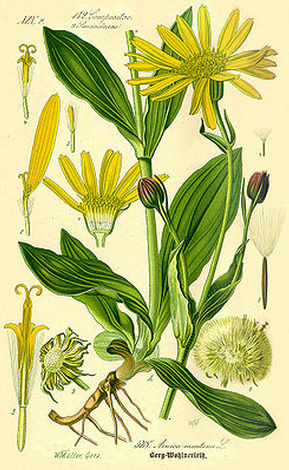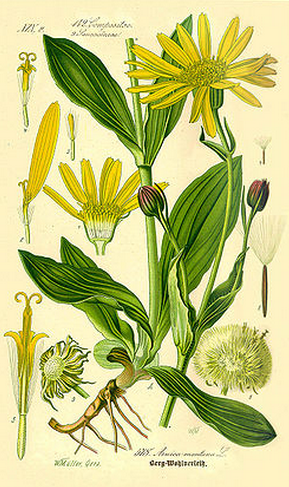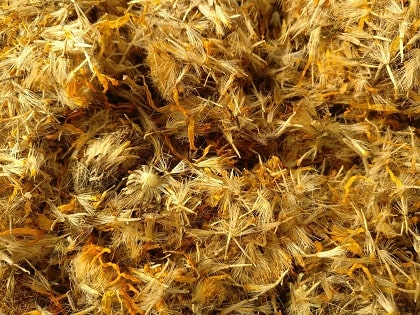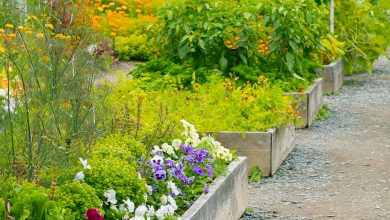What is Arnica good for? Be amazed by the uses of this wonderful medicinal plant

Arnica Montana has been used and is used against different ailments: from back pain to rheumatism through the regeneration of the skin and the stimulation of blood circulation.
If you want to know what arnica is good for, how to use it in natural remedies and its possible contraindications, in this article we will tell you all about it.
What is Arnica Montana?
The Arnica , Arnica montana L , popularly known as betony of the mountains and as snuff mountain is a medicinal plant used in folk medicine for hundreds of years.
Arnica is a plant native to Europe and belongs to the botanical family of Composites or Asteraceae, just like Artichokes , Lettuce , Dandelion , Calendula , Sunflower and Chamomile .
It grows to half a meter in height, with hair-covered leaves and orange-yellow flowers. It is a plant that grows wild in the mountains and has an aroma similar to chamomile.
Arnica flowers are mainly used for medicinal purposes because they are the ones that have the greatest therapeutic action, although the roots and rhizomes are also used but to a lesser extent.
This medicinal plant has many benefits for our health, let’s see what arnica is good for.
Medicinal properties of Arnica
This medicinal plant has flavonoids, carotenoids, curmarins, lignans, phenolic acids, diterpenes, bitter principles, volatile oils and amazine, among other components, which give this medicinal herb properties:
- Painkiller

- Rubefacient
- Anti-inflammatory
- Immunomodulatory
- Antioxidant
- Uterotonic
- Antibacterial
- Positive inotropic
- Astringent
- Fungicide
- Platelet antiplatelet
- Healing
- Antitumor
- Hepatoprotective
- Antirheumatic
- Bronchiodilator
- Choleretic
- Anxiolytic
- Vulnerary
- Cytoprotective
- Cough suppressant
If you want to have the peace of mind of taking advantage of the properties of arnica without the dangers of ingesting traces of pesticides, we always recommend choosing Organic Arnica , the best option to really take care of your health.
Arnica benefits and uses
It takes care of the health of our liver due to its hepatoprotective action and also promotes the elimination of bilirubin.
Prevents the formation of bruises or helps to eliminate them.
Strengthens hair and can help prevent hair loss
Helps relieve pain in blows, trauma, sprains….
Reduces swelling
Improves the contraction of the heart muscle, being positive to take care of the heart
Prevents the formation of thrombi and blood clots in blood vessels (such as arteries and veins)
May be useful in cases of chronic venous insufficiency
Arnica helps to improve our defenses and our immune system to function properly.
Fight coughing episodes.
Arnica can help improve skin problems
It stimulates the absorption of calcium from the bone and this strengthens it, being useful to help prevent osteoporosis.
Improves muscle and joint stiffness.
Avoid infections in wounds on the skin, mouth, etc.
For osteoarthritis it can be an ally
It is indicated in cases of frostbite
It improves our mood, being useful to help in cases of anxiety.
Promotes breathing
Arnica stimulates the uterus to contract. One of the most common uses of plants with uterotonic action is to prevent bleeding after childbirth.
Reduces pain when there are muscle tears or strains
Stimulates blood circulation, something especially interesting for people with diabetes
Accelerates recovery from sprains and dislocations
It protects our cells against oxidative damage from free radicals, therefore, it is interesting to help prevent diseases.
Apply arnica locally to prevent stretch marks on the skin
It has been shown to be useful in cases of respiratory system affections
Improves rheumatoid arthritis
Fight acne and improve the general condition of the skin by applying the arnica infusion with a cotton ball or gauze.
It is used to treat angina and pharyngitis
Eliminate fungi.
Supports good gum health and prevents pyorrhea
It can help prevent travel sickness
Helps heal wounds
Arnica can be our ally against cases of fungal and bacterial infections
Relieves cases of arthritis thanks to its analgesic and anti-inflammatory action.

Dried arnica montana flowers
Home remedies with Arnica
Arnica can be used internally by taking the infusion or taking a tincture of the plant. But it can also be added in the preparation of creams, ointments and poultices to apply externally and topically.
To prepare the arnica infusion , add a teaspoon of the dried flowers in a cup and add 200 ml of very hot water (it is not necessary to bring it to a boil). Cover and let stand 3 or 4 minutes, then filter and drink when it has cooled to room temperature.
* With the infusion of this medicinal plant we can make rinses or swish to avoid infections, heal sores, improve gum problems (pyorrhea) both in the mouth and in the pharynx.
* To improve sprains, bumps, dislocations or bruises, rubs or plasters are applied to the affected area.
* It can be used externally by including it in the preparation of creams and tonics to stimulate blood circulation.
Contraindications of use of Arnica
Its consumption during pregnancy is not recommended due to its stimulating action of the tonic and its potential for a possible abortion.
The only one should not be taken during the lactation period.
It should also not be used in children under 12 years of age.
Arnica should not be applied to open wounds or irritated skin.
It can interact with medications. If you are under drug treatment, consult your doctor before taking arnica.
Medicinal plants should not be consumed for more than 15 days in a row. After this period of time, you should rest for a week before taking it again.
This is general information. As with any medicinal plant, consult a professional before taking it to see if it may be useful in your case and if it is compatible with your medical history.
Consulted bibliography
- https://onlinelibrary.wiley.com/doi/full/10.1111/jphp.12724
- https://www.ncbi.nlm.nih.gov/pubmed/24875316
- http://www.scielo.org.mx/scielo.php?script=sci_arttext&pid=S2007-11322014000500008
- https://www.ncbi.nlm.nih.gov/pubmed/22958433
.
.

![Photo of Tagete: [Cultivation, Care, Irrigation and Reproduction]](https://www.complete-gardening.com/wp-content/uploads/2022/08/tagete-cultivation-care-irrigation-and-reproduction-390x220.jpg)
![Photo of 14 Types of Orchards: [Characteristics and Operation]](https://www.complete-gardening.com/wp-content/uploads/2021/06/col_rizada_1596697078-390x220.jpg)

![Photo of Aloe Vera: [Planting, Care, Irrigation, Substrate and Pests]](https://www.complete-gardening.com/wp-content/uploads/2022/08/aloe-vera-planting-care-irrigation-substrate-and-pests-390x220.jpg)